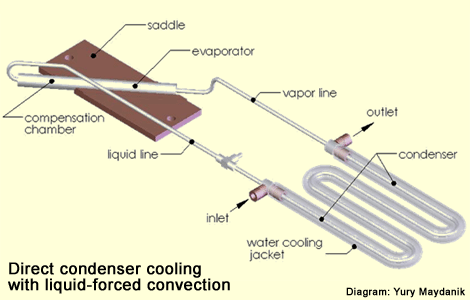
A diagram of a loop heat pipe (LHP) developed by Passive Thermal Technology.
Can satellite cooling technology allow computing clouds do more for less? Several veterans of the high-performance computing industry believe it can, and recently pitched their technology at the SuperComputing 08 conference in Austin. Their goal: to get a major cloud platform interested in custom 1U servers using their cooling solution.
The technology is a loop heat pipe (LHP), an adaptation of a cooling system used in satellites and gaming PCs. Passive Thermal Technology Inc. has developed a prototype 1U server using the LHP, which removes heat directly from the processor. The company's technology was developed by CTO Stephen Fried, who is also the president and co-founder of high performance computing vendor Microway.
Fried has been working for several years to adapt heat pipes for use in high-density data center installations. Heat pipes are becoming more common in laptops, game systems and high-performance PCs, and Fried says Passive Thermal already has contracts with several graphics processing unit (GPU) vendors.
But he believes that huge data centers may offer the best value proposition for loop heat pipes. "What we have demonstrated is the ability to cool a data center with no chillers," said Fried. "We don't need a water chiller at all, ever."
There are significant barriers to adoption of heat pipe cooling in data centers. Passive Thermal's technology is not an exterior "add-on" technology that can be adapted in existing data centers. The heat pipes must be built into servers, and bring water inside the server chassis. Fried is hoping to connect with a server OEM or cloud data center builder that could consider a commitment to custom low-power 1U servers.
Passive Thermal's loop heat pipe is one of a number of approaches that seek to bring advanced cooling systems inside the server. Existing approaches include on-chip liquid cooling solutions from SprayCool, or IBM's Hydro-Cluster technology using water-chilled copper plates for processor-level cooling for supercomputers.
Heat pipes contain gas that condenses to liquid form, and then returns to the hot interface through passive capillary action. They have been used for many years in satellites, which use high-powered transmitters that generate large amounts of heat, creating “hot spots” in space where there is no air to support fan cooling. Ammonia-filled heat pipes with radiators on the satellite's exterior proved to be the solution.
When Fried began marketing heat pipes for data center use at a conference last year, he was advancing the use of ammonia in the heat pipes, similar to the approach used in satellites. Passive Thermal's approach has since been refined through collaboration with Yury Maydanik from the Russian Academy of Sciences, who has conducted years of research on the use of miniature loop heat pipes for cooling electronics.
"Ammonia is pretty good, but we've figured out how to do the same thing with water," said Fried. The water would not need to be chilled, eliminating the need for energy-hungry chillers. The heat pipes would remove the heat from processors, but some air flow would still be needed inside the server chassis to cool memory chips, Fried said.
For readers interested in a detailed description, Passive Thermal provided a summary from Alan Torres of The Torres Group LLC.
PTT’s Loop Heat Pipe technology (is) based on a two-phase passive device. It employs a very small evaporator, condenser and pipes. The evaporator contains a wick that transfers the heat rejected by the processor to the working fluid inside the LHP. The wick also provides the capillary pressure that drives the working fluid around a cooling loop whose length can be measured in meters. This loop includes a device called the condenser, which is cooled by water or air.
The function of the condenser is to return the vapor to a liquid, thereby completing the cycle, while rejecting the heat to the air or water used to cool the condenser. The size of these LHP’s are small enough to be used in 1U Rack Servers, Blades, COTS systems, Avionics and also makes it possible to cool GPU cards that take up a single slot while rejecting 250 or more Watts using the existing cooling fan.
The Passive Thermal web site provides limited information about the technology, but offers an overview in a short white paper.




